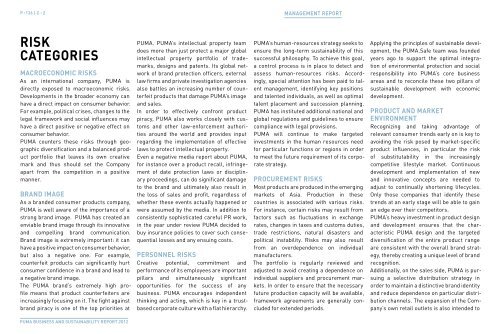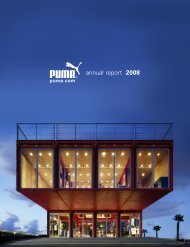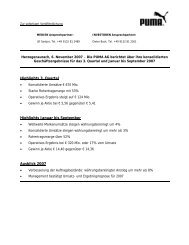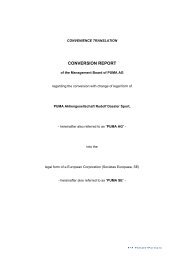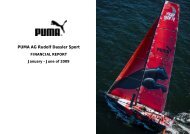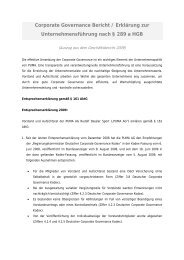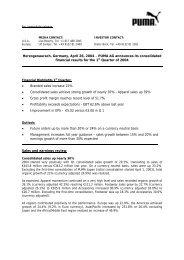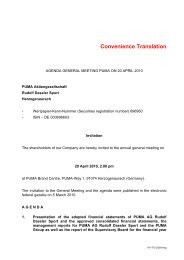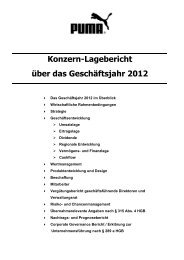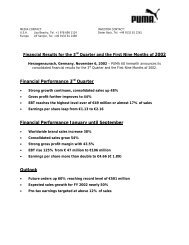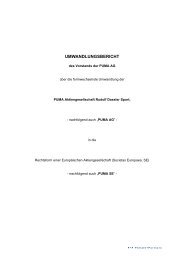Html - PUMA CATch up
Html - PUMA CATch up
Html - PUMA CATch up
You also want an ePaper? Increase the reach of your titles
YUMPU automatically turns print PDFs into web optimized ePapers that Google loves.
p : 136 | c : 2<br />
risk<br />
categories<br />
macroeconomic risks<br />
As an international company, <strong>PUMA</strong> is<br />
directly exposed to macroeconomic risks.<br />
Developments in the broader economy can<br />
have a direct impact on consumer behavior.<br />
For example, political crises, changes to the<br />
legal framework and social influences may<br />
have a direct positive or negative effect on<br />
consumer behavior.<br />
<strong>PUMA</strong> counters these risks through geographic<br />
diversification and a balanced product<br />
portfolio that leaves its own creative<br />
mark and thus should set the Company<br />
apart from the competition in a positive<br />
manner.<br />
Brand image<br />
As a branded consumer products company,<br />
<strong>PUMA</strong> is well aware of the importance of a<br />
strong brand image. <strong>PUMA</strong> has created an<br />
enviable brand image through its innovative<br />
and compelling brand communication.<br />
Brand image is extremely important: it can<br />
have a positive impact on consumer behavior,<br />
but also a negative one. For example,<br />
counterfeit products can significantly hurt<br />
consumer confidence in a brand and lead to<br />
a negative brand image.<br />
The <strong>PUMA</strong> brand’s extremely high profile<br />
means that product counterfeiters are<br />
increasingly focusing on it. The fight against<br />
brand piracy is one of the top priorities at<br />
pUMa BUsiness and sUstainaBility RepoRt 2012<br />
<strong>PUMA</strong>. <strong>PUMA</strong>’s intellectual property team<br />
does more than just protect a major global<br />
intellectual property portfolio of trademarks,<br />
designs and patents. Its global network<br />
of brand protection officers, external<br />
law firms and private investigation agencies<br />
also battles an increasing number of counterfeit<br />
products that damage <strong>PUMA</strong>’s image<br />
and sales.<br />
In order to effectively confront product<br />
piracy, <strong>PUMA</strong> also works closely with customs<br />
and other law-enforcement authorities<br />
around the world and provides input<br />
regarding the implementation of effective<br />
laws to protect intellectual property.<br />
Even a negative media report about <strong>PUMA</strong>,<br />
for instance over a product recall, infringement<br />
of date protection laws or disciplinary<br />
proceedings, can do significant damage<br />
to the brand and ultimately also result in<br />
the loss of sales and profit, regardless of<br />
whether these events actually happened or<br />
were assumed by the media. In addition to<br />
consistently sophisticated careful PR work,<br />
in the year under review <strong>PUMA</strong> decided to<br />
buy insurance policies to cover such consequential<br />
losses and any ensuing costs.<br />
personnel risks<br />
Creative potential, commitment and<br />
performance of its employees are important<br />
pillars and simultaneously significant<br />
opportunities for the success of any<br />
business. <strong>PUMA</strong> encourages independent<br />
thinking and acting, which is key in a trustbased<br />
corporate culture with a flat hierarchy.<br />
ManageMent RepoRt<br />
<strong>PUMA</strong>’s human-resources strategy seeks to<br />
ensure the long-term sustainability of this<br />
successful philosophy. To achieve this goal,<br />
a control process is in place to detect and<br />
assess human-resources risks. Accordingly,<br />
special attention has been paid to talent<br />
management, identifying key positions<br />
and talented individuals, as well as optimal<br />
talent placement and succession planning.<br />
<strong>PUMA</strong> has instituted additional national and<br />
global regulations and guidelines to ensure<br />
compliance with legal provisions.<br />
<strong>PUMA</strong> will continue to make targeted<br />
investments in the human resources need<br />
for particular functions or regions in order<br />
to meet the future requirement of its corporate<br />
strategy.<br />
procurement risks<br />
Most products are produced in the emerging<br />
markets of Asia. Production in these<br />
countries is associated with various risks.<br />
For instance, certain risks may result from<br />
factors such as fluctuations in exchange<br />
rates, changes in taxes and customs duties,<br />
trade restrictions, natural disasters and<br />
political instability. Risks may also result<br />
from an overdependence on individual<br />
manufacturers.<br />
The portfolio is regularly reviewed and<br />
adjusted to avoid creating a dependence on<br />
individual s<strong>up</strong>pliers and procurement markets.<br />
In order to ensure that the necessary<br />
future production capacity will be available,<br />
framework agreements are generally concluded<br />
for extended periods.<br />
Applying the principles of sustainable development,<br />
the <strong>PUMA</strong>.Safe team was founded<br />
years ago to s<strong>up</strong>port the optimal integration<br />
of environmental protection and social<br />
responsibility into <strong>PUMA</strong>’s core business<br />
areas and to reconcile these two pillars of<br />
sustainable development with economic<br />
development.<br />
product and market<br />
environment<br />
Recognizing and taking advantage of<br />
relevant consumer trends early on is key to<br />
avoiding the risk posed by market-specific<br />
product influences, in particular the risk<br />
of substitutability in the increasingly<br />
competitive lifestyle market. Continuous<br />
development and implementation of new<br />
and innovative concepts are needed to<br />
adjust to continually shortening lifecycles.<br />
Only those companies that identify these<br />
trends at an early stage will be able to gain<br />
an edge over their competitors.<br />
<strong>PUMA</strong>’s heavy investment in product design<br />
and development ensures that the characteristic<br />
<strong>PUMA</strong> design and the targeted<br />
diversification of the entire product range<br />
are consistent with the overall brand strategy,<br />
thereby creating a unique level of brand<br />
recognition.<br />
Additionally, on the sales side, <strong>PUMA</strong> is pursuing<br />
a selective distribution strategy in<br />
order to maintain a distinctive brand identity<br />
and reduce dependence on particular distribution<br />
channels. The expansion of the Company’s<br />
own retail outlets is also intended to


